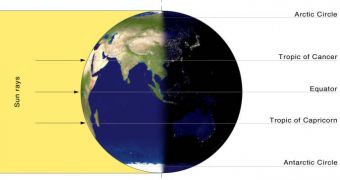Equinoxes are cosmic events that take place twice every year, when the axis of the planet is not inclined nor towards, neither away from the Sun. Rather, the light rays shine directly perpendicular to the Equator, making the night and day times approximately equal.
They occur around March 20th-21st and September 22nd-23rd each year, and do not last an entire day, but roughly a moment. For example, this year, the moment that marks the beginning of spring will be at 11:44 UTC on March 20th, while the autumn equinox will take place on September 22nd, at 21:18 UTC.
Over the past 150 years, Earth scientists have learned that the disposition of these moments throughout the year have begun to stop coinciding with the actual moments when spring and autumn, respectively, begin. That is to say, they have recorded a two-day shift in each of the seasons. Spring actually begins about 48 hours before its equinox, and this also applies to the autumn one as well.
Even the hottest and the coldest days of the year have started occurring on average 48 hours before their expected times. There are a number of possible explanations for these events, including the fact that the planet's orbit around the Sun, as well as its inclination, are constantly subjected to influences from both the star and the gravitational pull of other celestial bodies around us.
Some say that global warming also plays an important role in this occurrence, as the billion tons of carbon that are emitted into the atmosphere each year upset the delicate balance of gases on which temperatures rely for control. Such disturbances are bound to bring forth weather manifestations the likes of which have never been recorded in written history. Droughts and floods are expected to occur with increased frequencies, and previously cold places are about to experience large increases in their mean temperatures.
The reason why these days are not the hottest of the year, even though that should theoretically be the case, is the thermal inertia of the world's oceans. In other words, it takes from March to about August, namely about six months, for the seas to get warm enough to prompt the temperatures that make the 8th month of the year the warmest one.

 14 DAY TRIAL //
14 DAY TRIAL //